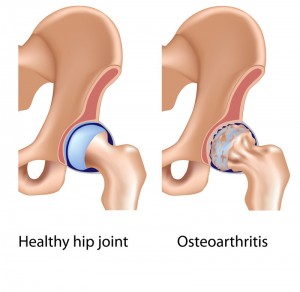by SPORTSDOC RAJ
Following total hip replacement surgery, patients typically begin physiotherapy almost immediately. Starting on the first postoperative day, patients commonly begin minor physiotherapy while sitting upright in a hospital chair.
Eventually, rehab will incorporate taking steps, walking longer distances, and stair climbing. At first, supportive devices such as walkers or crutches are used,  and levels of pain are closely monitored. While a certain degree of pain should be expected, the vast majority of patients will notice they have substantial relief from their preoperative level of pain.
and levels of pain are closely monitored. While a certain degree of pain should be expected, the vast majority of patients will notice they have substantial relief from their preoperative level of pain.
Rehabilitation is very important in the overall outcome of any joint replacement surgery. Goals of physiotherapy include preventing contractures (permanent shortening of muscles), improving patient education, as well as strengthening the muscles surrounding the operative joint by way of controlled exercises.
When patients are discharged from the hospital after a total hip replacement, they are specifically instructed not to strain their hip joint with activities, such as heavy lifting. Instructions on proper body posturing, sitting, or utilizing an elevated toilet seat at home can be extremely helpful. In addition, hip replacement patients are told not to cross the affected leg over the other leg to reduce the risk of dislocating the new joint.
It is also strongly recommended that they avoid bending at the waist. In order to prevent the operative leg from crossing over the midline, patients are given instructions on how to place a pillow between their legs when lying on their “good” side.
Hip patients are provided with an individual home exercise program in order to help strengthen the buttock and thigh muscles. Most patients go to outpatient physiotherapy sessions for several while also performing regular exercises at home. Occupational therapists are health care professionals who are also part of a total hip replacement patient’s rehabilitation team. They educate patients concerning various assistive devices that are available as well as the correct ways to perform their activities of daily living (ADLs).
Rehabilitation Dos and Don’ts
Precautions regarding hip replacement rehabilitation vary depending on the postoperative approach a particular Los Angeles orthopaedic surgeon uses. The patient’s doctor and physiotherapist will give them a list of precautions to use at home. These precautions help to prevent dislocation of the new joint and promote the healing process. Some of the most common dos and don’ts include the following:
Do:
- Maintain the leg in a forward facing position.
- Keep the operative leg in front when transitioning to sitting or standing positions.

- Use high chairs and elevated toilet seats.
- Kneel on the operative leg.
- Utilize ice to alleviate pain and/or swelling. However, it is important to remember that ice diminishes pain sensation. Do not apply ice directly to the skin. Always wrap an ice pack in a dampened towel.
- Apply heat (a heat pack or heating pad) for 15 to 20 minutes prior to exercise sessions to help with range of motion.
- Cut back on exercising if muscles start to ache. However, do not stop completely!
Don’t:
- Cross the legs at the knees for a minimum of eight weeks.
- Bring the knee up higher than the new hip joint.
- Lean forward when sitting and/or when sitting down.
- Try to pick up something that is on the floor when in a sitting position.
- Turn the feet excessively outward and/or inward when bending down.
- Reach down to try to pull blankets up while lying in bed.
- Bend at the waist more than ninety degrees.
- Stand in a pigeon-toed stance.
- Kneel on the non operative leg.
- Use pain as a gauge for what can or cannot be accomplished.


